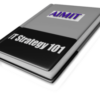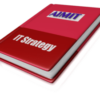Why Presentation Is Your Second Elevator Pitch
He had the experience. He had the credentials. He even had the CIO’s attention.
But when it came time to follow up, all he sent was a flat PDF — a 60-slide deck packed with technical jargon and generic process charts. No case studies. No measurable outcomes. No visual proof of impact.
The CIO passed. Not because the consultant lacked skills — but because the work didn’t speak for itself.
“Stories are just data with a soul.” – Brené Brown
CIOs are drowning in vendor pitches, internal fires, and strategic decisions. They don’t have time to decode your expertise. If your portfolio isn’t clear, credible, and connected to their priorities, it won’t get read — let alone win the deal.
That’s why your documents, presentations, and tools aren’t just deliverables. They’re your second elevator pitch. And they better be good.
Let’s make them irresistible.
I. Your Expertise Is Invisible Until You Make It Tangible
In the world of consulting, brilliance means nothing if it’s invisible. You may have the sharpest insights, the most relevant experience, and the perfect solution to a CIO’s challenge — but unless you can show that value in a way that’s immediate, relevant, and compelling, it won’t move the needle.
Consultants live and die by credibility. And in the eyes of a CIO, credibility isn’t just built on what you say — it’s built on what you prove. That proof doesn’t come from your elevator pitch, your resumé, or your credentials alone. It comes from how well you package your expertise into documents, presentations, and frameworks that clearly demonstrate business impact.
The modern CIO is a high-velocity decision-maker. They’re navigating digital transformation, risk management, cost pressures, vendor overload, and internal talent gaps — often all in the same week. They simply don’t have time to decode your brilliance. They’re not going to dig through 40-slide decks or wordy white papers hoping to find the one line that connects to their current pain point. If your content doesn’t speak clearly and immediately to their concerns — ROI, scalability, security, strategy — it’s dead on arrival.
That’s why your portfolio isn’t a vanity exercise — it’s your frontline sales tool. It’s your proof of relevance. It’s your silent pitch. A good portfolio doesn’t just tell your story — it makes the CIO the hero of that story, with you as the enabler.
But here’s the challenge: most consultants don’t treat their portfolio as a strategic asset. They treat it as an afterthought — a collection of mismatched decks, dated PDFs, and generic case studies that aren’t tailored to the audience. Or worse, they don’t have one at all. They rely on real-time explanations to close the deal, hoping their charisma will carry them across the finish line.
That’s no longer enough. In a crowded and competitive consulting market, you must lead with clarity, credibility, and content that works as hard as you do. Your documents must be organized, branded, relevant, and instantly accessible. And more importantly, they must speak the language of business outcomes — not just methodologies and frameworks.
This article will walk you through how to craft and curate a high-impact consulting portfolio — one that speaks directly to CIO priorities and positions you as a trusted, strategic partner. You’ll learn what kinds of content to include, how to structure it for maximum impact, and what common mistakes to avoid.
Even more importantly, you’ll see how CIO Index can be your platform to bring this all together. With our document library, tagging system, and personal branding tools, you can showcase your work in one place — organized around their problems, not just your process. You can position yourself to be discovered, not just introduced. And when the right CIO stumbles upon your case study, research, or toolkit — you’ll already be halfway to the deal.
Because in consulting, perception isn’t just reality — it’s opportunity. And it starts with how you present your work.
Let’s get started.
II. The CIO’s Mindset: What They’re Really Looking For
To win over a CIO, you have to think like one.
CIOs are not just gatekeepers of technology — they’re stewards of business value, innovation, and risk. They’re measured not by how many systems they deploy, but by how well those systems drive competitive advantage, reduce cost, improve resilience, and enable scale. Every decision they make is scrutinized through multiple lenses: financial impact, operational feasibility, strategic alignment, and organizational risk.
That’s why, when they look at a consultant’s portfolio, they’re not scanning for clever frameworks or polished graphics. They’re scanning for relevance. They’re asking:
- Can this person help me deliver outcomes that matter?
- Can I trust them to understand the complexity of my environment?
- Can they move fast without breaking things — or getting me fired?
To answer those questions before they even ask them, your portfolio must reflect the five core priorities CIOs care about most:
1. Business Outcomes
ROI, agility, cost reduction, revenue impact
CIOs are under constant pressure to prove the business value of IT. Every dollar spent on technology must either reduce operating costs, unlock new capabilities, or accelerate time to value. If your case studies or tools don’t tie directly to measurable business outcomes — think reduced costs, faster deployment, increased user adoption — they won’t make an impression. Even qualitative impact must be framed in the context of agility, resilience, or competitive differentiation.
2. Scalability & Growth
Enterprise readiness, future-proofing, elasticity
CIOs aren’t just solving today’s problem — they’re preparing for tomorrow’s complexity. Whether it’s expanding globally, supporting M&A, or enabling digital products, scalability is a non-negotiable. Your materials should show how your solution scales across departments, geographies, or workloads. Highlight the architecture, governance, or design principles that made it sustainable.
3. Security & Compliance
Risk mitigation, regulatory alignment, data governance
If it compromises security, it’s a non-starter. If it fails to meet compliance requirements, it’s a liability. CIOs are deeply risk-aware, especially in industries like healthcare, finance, or government. Showcase how your work factored in security controls, governance frameworks, or regulatory mandates. Even a single slide noting “HIPAA alignment” or “zero trust model implementation” signals maturity.
4. Technical Fit
Integration, interoperability, performance optimization
A great idea that can’t plug into the current stack is just a theory. CIOs look for consultants who understand the constraints of legacy systems, the nuances of modern architectures, and the reality of hybrid infrastructure. Your documents should clearly demonstrate how your solution worked within an environment — not just in theory, but in messy, real-world contexts.
5. Strategic Alignment
Vision, roadmap, governance, transformation support
CIOs are not interested in one-off fixes. They want partners who understand how technology supports the business vision. Your materials should tie your work to broader strategic initiatives — digital transformation, customer experience, data strategy, or IT governance. Show how you connected the dots between business strategy and technology execution.
Trust Markers CIOs Look For
Even if your content hits all the right notes, if it looks like a student project, it will be dismissed. CIOs instinctively trust work that appears polished, intentional, and structured. Some trust markers to include:
- Professional formatting – Clean layout, coherent flow, and brand consistency
- Meaningful metrics – KPIs, business results, and comparisons before/after
- Client testimonials – Concise, attributed, and results-focused quotes
- Clear relevance – Content is industry-specific, problem-specific, or context-aware
When your portfolio maps directly to CIO concerns and is delivered with clarity and credibility, you instantly stand out from the noise. You’re not just another vendor — you’re a strategic partner speaking their language.
III. Anatomy of a Winning Portfolio
A great consulting portfolio doesn’t just say “Here’s what I do.” It says, “Here’s how I’ve helped people like you — and how I’ll help you next.” It’s not a stack of artifacts; it’s a curated, strategic story told through evidence. And to resonate with CIOs, that story must be structured, relevant, and deeply rooted in outcomes.
Here’s what belongs in every high-impact portfolio — and how to craft each element to speak directly to CIO priorities.
A. Case Studies
Your case studies are the anchor of your portfolio — they’re where outcomes meet evidence. But most consultants treat them like war stories: long, dense, and internally focused. CIOs don’t want a blow-by-blow of your process — they want a crisp story arc with a clear business payoff.
Use a three-part structure:
Problem → Solution → Outcome
- Problem: What challenge was the client facing? Be specific — cost overrun, cloud sprawl, compliance risk.
- Solution: What exactly did you do? Highlight the approach, methodology, or tech used.
- Outcome: What happened? Use metrics that matter:
- Cost savings in dollars or percentages
- Performance boosts (e.g., deployment speed, uptime)
- Risk reduction (e.g., compliance success, fewer incidents)
Bonus: Include a client quote — short, sharp, and attributed. Nothing builds trust like a satisfied voice saying, “This worked.”
B. Presentations
Slide decks are still one of the most powerful communication tools in the CIO world — but only when used right. A good presentation doesn’t just explain what you offer; it frames the problem and leads the viewer through a transformation journey.
Use storytelling:
- Show the before and after
- Highlight business drivers, not just technical tasks
- Use visuals: roadmaps, architecture diagrams, phased rollouts
Leverage familiar frameworks:
CIOs don’t need you to invent new language. Anchor your ideas in frameworks they already use — TOGAF, ITIL, COBIT, Agile, etc. This signals fluency and maturity.
Avoid jargon:
Make the benefits pop. Instead of “automated pipeline optimization,” say “cut build time from 4 hours to 15 minutes.” Translate your magic into results.
C. Research & White Papers
Thought leadership matters — especially when CIOs are looking for guidance on complex or emerging issues. If you can synthesize a trend and connect it to actionable insights, you’re already ahead.
What to include:
- Market or tech trend analysis
- Benchmark comparisons
- Strategic guidance or maturity models
Make it urgent:
Use data, headlines, or market shifts to explain why this matters now. CIOs respond to context — tie your insights to competitive risk or opportunity.
Always connect to action:
End with a recommended next step, model, or decision path. Leave the reader thinking, “We need to do something about this — and this consultant gets it.”
D. Tools & Templates
This is the most overlooked — and most valuable — asset class in a portfolio. CIOs love tools that accelerate thinking, simplify planning, or support internal buy-in.
Examples:
- ROI calculators
- Cyber risk scorecards
- IT governance checklists
- Cloud cost estimation tools
- Digital maturity assessments
These assets make you not just a thinker, but a doer. They also make great lead magnets — content you can share with CIOs to initiate engagement or follow up after a meeting. If your tools help them make better decisions faster, they’ll remember you.
E. Testimonials & Endorsements
You can say you’re credible — or you can let others say it for you. Testimonials validate everything else in your portfolio. But not all quotes are created equal.
Use real voices. Keep it concise. Make it count.
Instead of generic praise (“John was great to work with”), focus on credibility-building statements:
- “Delivered the project 3 weeks early and saved us 18% in licensing costs.”
- “Helped us go from fragmented governance to a scalable IT strategy in under 90 days.”
- “Brought structure, insight, and a sense of urgency — exactly what we needed.”
Even two or three well-placed quotes can turn your portfolio from good to believable.
When you assemble these five components with intention and clarity, you’re not just showcasing your work — you’re telling a story that makes a CIO think, “This is the person who can help me.” That’s when the real conversations begin.
IV. Mistakes That Kill Credibility
A brilliant consultant can lose a deal simply by presenting their work poorly. Your portfolio is a reflection of your thinking — and if it’s disorganized, confusing, or generic, CIOs will assume your solutions are too. Credibility isn’t just about what you’ve done. It’s about how clearly and confidently you can communicate why it matters.
Here are the most common portfolio mistakes that quietly sabotage your chances — and how to avoid them.
1. No Business Translation of Tech Talk
If your content reads like an engineering manual, you’ve already lost the room. CIOs are technical, yes — but their decisions are business-driven. They need to understand how your work translates to value, risk reduction, or strategic momentum.
Mistake:
- “Implemented a microservices architecture with CI/CD pipelines using Jenkins and Kubernetes.”
Better:
- “Reduced deployment time by 80% by restructuring legacy systems into modular, scalable services.”
Every case study, slide, or white paper should answer: What’s the business result? If it doesn’t, rework it.
2. Poor Formatting or Generic Templates
Great insights buried in dense slides or wordy documents won’t be read — or remembered. CIOs are visual and fast-moving. They scan, skim, and decide in seconds.
Mistake:
- Using a stock PowerPoint template from 2008
- Walls of text, inconsistent fonts, or clashing colors
- Lack of clear structure or headings
Better:
- Clean layout with whitespace, headers, and consistent visual style
- Tailored visuals: before/after charts, roadmaps, infographics
- One idea per slide or section, clearly labeled
Your formatting is your first impression. Make it look like you care.
3. PDF Overload Without Summaries or Previews
A folder full of PDFs is not a portfolio — it’s a graveyard. CIOs don’t have time to open, scroll, and interpret every document. If there’s no context, they won’t bother.
Mistake:
- Uploading 10 PDFs with filenames like “Client_A_Final_v3”
- No summaries, tags, or logical grouping
Better:
- Include a short, scannable summary for each document (2–3 sentences)
- Group content by theme or challenge (e.g., “Cloud Cost Optimization Toolkit”)
- Offer previews or key takeaways at a glance
Don’t make them dig. Serve it up clearly and quickly.
4. Outdated Material or Broken Links
Few things erode trust faster than old content or inaccessible files. CIOs assume if you can’t keep your own assets current, you won’t keep their initiatives on track either.
Mistake:
- Case studies from 2015
- Outdated frameworks or stats
- Broken links or “file not found” errors
Better:
- Keep your top 3–5 pieces updated annually
- Add a “last updated” date to research
- Regularly test links and document access
Your portfolio should evolve with your expertise — and the market.
5. Content Mismatch
Sending generic content to the wrong audience signals one thing: you don’t understand them. CIOs expect content tailored to their world — their industry, their size, their stage of maturity.
Mistake:
- Sharing a Fortune 100 transformation case study with a mid-market CIO
- Using retail examples for a healthcare client
- Presenting overly advanced material to a team just starting cloud migration
Better:
- Match case studies to their vertical, scale, and maturity
- Customize intros or annotations to show relevance
- Segment your portfolio (e.g., “For Mid-Market CIOs” or “For Regulated Industries”)
Relevance builds trust — and trust drives engagement.
Bottom line: A polished, targeted, and business-aligned portfolio builds instant credibility. Avoid these mistakes, and your content will stop being ignored — and start opening doors.
V. The Consultant’s Secret Weapon: Centralized, Curated, and Contextual
You’ve done the work. You’ve captured the outcomes. But if your best thinking is scattered across emails, folders, and outdated decks, you’re not leveraging your most powerful asset: your portfolio.
A well-constructed portfolio doesn’t just showcase what you’ve done — it positions you to get found, to build trust instantly, and to respond to CIO concerns with precision. And when hosted and structured the right way, it becomes your silent pitch machine — working 24/7 to open conversations you haven’t even started yet.
That’s where CIO Index becomes your secret weapon.
A. Organize Your Portfolio in One Place
CIO Index gives you a dedicated, centralized space to showcase your expertise. No more hunting through files or fumbling with attachments.
Upload and manage your core assets:
- Case studies
- Presentations
- Tools and templates
- Research and white papers
- Testimonials
All of it lives in a branded, high-trust environment designed specifically for CIO audiences. No Dropbox links. No clunky attachments. Just clean, immediate access.
Better yet: It’s fully searchable, categorized, and structured for business decision-makers. You’re not just sharing a file — you’re inviting the CIO into your body of work, organized for them.
B. Align Portfolio to CIO Concerns
Every CIO is trying to solve a specific set of problems — and they want to know if you’ve solved that problem before. CIO Index helps you meet them where they are.
Tag your content by the priorities that matter most:
- Security
- Scalability
- Cost optimization
- Strategic alignment
- Cloud, data, governance, etc.
You can also organize your assets by industry or challenge — think “Digital Transformation in Healthcare” or “Cloud Cost Management for Mid-Market Companies.”
Want to go even further? Build solution sets: curated collections of documents designed to tackle a single CIO challenge. For example:
- IT Governance Toolkit for Growth-Stage Companies
- Legacy Modernization Case Set
- Zero Trust Playbook: Strategy + Metrics + Templates
When you make it easy for a CIO to see how your experience maps to their challenge, you move from “interesting” to “essential.”
C. Build Trust Through Consistency
Professionalism isn’t just about polish — it’s about coherence. CIOs notice when your work feels consistent across touchpoints.
On CIO Index, you can:
- Use consistent branding — logos, color palettes, tone
- Apply naming conventions that show you’ve thought this through
- Ensure every asset is directly tied to your consultant profile
- Your case study doesn’t float alone — it links to your bio, services, and other resources
- When they like one thing, they find the rest of you easily
This consistency creates a “whole picture” impression. You don’t just look capable — you look prepared.
D. Measure What Resonates
Wouldn’t it be useful to know which documents are doing the heavy lifting?
With CIO Index’s built-in analytics, you can track:
- Which assets get viewed most often
- What gets downloaded, clicked, or shared
- Which topics generate interest over time
This data helps you double down on what works and refine what doesn’t.
If your cybersecurity toolkit is getting traction, build a deeper version. If no one clicks your cloud strategy deck, rework the framing.
You’re not just building a portfolio — you’re building a feedback loop. One that improves your positioning with every interaction.
In short, CIO Index turns your body of work into a strategic growth engine. It centralizes your content, aligns it to the buyer’s priorities, showcases it professionally, and feeds you insights in return.
That’s not just smart. That’s consulting at scale.
VI. Case in Point: Consultant Success Story
Sometimes the best sales pitch is the one you never have to make.
Take the story of Priya, an independent IT strategy consultant who had been struggling with visibility. She had decades of experience, had led major transformation efforts at Fortune 500 companies, and had a track record of results. But without a centralized way to showcase her work, every client conversation started from scratch. Every pitch was manual. Every intro required explaining her value all over again.
Then she uploaded her portfolio to CIO Index.
She started with three items:
- A framework for prioritizing digital initiatives based on business impact
- A case study highlighting how she helped a mid-sized healthcare company reduce IT operating costs by 22%
- A toolkit that included a maturity model and a roadmap template for IT governance
She tagged her assets carefully — “cost optimization,” “healthcare,” “strategic alignment” — and made sure each one was summarized in clear, results-focused language.
Then she let the platform do the work.
Two weeks later, a CIO from a regional hospital network browsing the CIO Index feed stumbled upon her governance toolkit. That led to a click on the case study, which led to a visit to her profile. Within days, she had a message in her inbox:
“Saw your toolkit and case study — very relevant to what we’re dealing with. Can we talk about a roadmap engagement?”
No cold call. No sales deck. No pitch.
Just the right content, in the right place, at the right time — doing what it was designed to do: build trust and drive action.
Three weeks later, she signed a six-month strategy engagement with that CIO’s team.
“I didn’t even pitch — the portfolio did it for me.” — Priya, IT Strategy Consultant
This isn’t luck. This is what happens when your portfolio is discoverable, relevant, and connected to real CIO concerns.
When your work speaks for itself, it doesn’t whisper — it wins.
VII. Final Checklist: Ready-to-Share Portfolio
Before you hit “send” or share a link with a CIO, ask yourself one question: Would I trust this person based on what I see here?
Your portfolio is your proxy. It speaks when you’re not in the room. And if it’s clear, credible, and targeted, it will do more than open doors — it will earn respect before the first conversation even happens.
Here’s a final checklist to make sure your portfolio is ready to do its job:
✅ Case Studies with Outcomes
- Each one tells a clear story: problem → solution → result
- Results are framed in business terms (cost savings, efficiency, growth)
- Includes client quotes or proof points where possible
✅ Presentations with Structure and Clarity
- Visual, easy to follow, and relevant to CIO-level concerns
- Uses known frameworks (TOGAF, ITIL, Agile, etc.)
- Business value is front and center, not buried in tech jargon
✅ Tools & Templates That Add Value
- ROI calculators, roadmaps, maturity models, checklists
- Easy to understand and use — no instruction manual required
- Helps CIOs act faster or think differently
✅ Research That Builds Authority
- Well-organized thought leadership, trend analysis, or benchmarking
- Connects to real-world decisions CIOs are making now
- Shows you’re ahead of the curve, not just riding it
✅ Branded, Consistent Design
- Cohesive look and feel across all assets (fonts, colors, layout)
- Professional formatting that signals attention to detail
- Makes your work look as good as it is
✅ Organized and Tagged by CIO Concern
- Assets categorized by challenge: security, cost, growth, etc.
- Easy for a CIO to find what’s most relevant to their situation
- Bonus: Create solution sets or industry-specific groupings
✅ Hosted and Shared via CIO Index
- Centralized, searchable, and branded environment
- No clunky attachments or dead Dropbox links
- Content linked to your profile — every document leads back to you
✅ Analytics to Track Engagement
- Know what’s being viewed, shared, or clicked
- Use insights to refine your portfolio
- Double down on what’s resonating with the market
Treat your portfolio like a living product — evolve it, test it, improve it. With this checklist, you’ll ensure it’s always ready to impress, persuade, and close.
VIII. Conclusion: Let Your Work Speak Before You Do
In a world where attention is short and decisions are high-stakes, your portfolio isn’t just a pitch tool — it’s your silent salesperson. It works when you’re not in the room. It makes an impression before you ever speak. And when crafted with clarity and purpose, it becomes one of the most powerful levers in your consulting practice.
CIOs aren’t just buying expertise — they’re buying confidence. They want to see that you’ve solved problems like theirs. They want to trust that you understand their world. And they want to know, quickly and clearly, that you can help them move forward.
That’s what a great portfolio does. It removes doubt. It builds momentum. It opens doors.
And with CIO Index, you have a platform designed specifically to help you do that — with centralized hosting, tagging, client-focused organization, and built-in visibility to the very audience you’re trying to reach.
Your work deserves to be seen. Your insights deserve to be discovered. And your next opportunity may already be browsing the feed — looking for someone who solves exactly what you’ve already solved.
So don’t wait for the next meeting to show your value.








